Noh Oshima Bulletin
The cover stories of our bulletins published twice a year.
№10 cover story (2004/09/20)
Flowing along a Giant Current
OSHIMA Kinue
It is already half a year since my grandfather Hisami passed away. We are truly grateful to all the people for attending his funeral.
During this time, I felt his eyes on me and heard him talking to me. He was a man of great care even to every little thing; I was often scolded when I did things loosely.
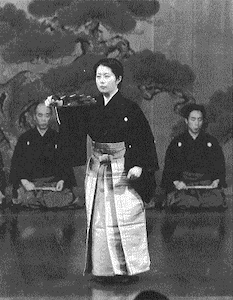 To my brother, sisters, and me, he was an absolute master rather than my grandfather. I have felt uneasy since we lost him last March, for we all relied on him. But I have to regard this farewell as a turning point of the giant current, to brace myself, and to get over the tide wave.
To my brother, sisters, and me, he was an absolute master rather than my grandfather. I have felt uneasy since we lost him last March, for we all relied on him. But I have to regard this farewell as a turning point of the giant current, to brace myself, and to get over the tide wave.
I will perform "Yugao" at this Regular Noh Performance. It has been three years since I played Shite on the stage. As a number of people have supported me, I am really happy. My "Yugao" is far behind from my grandfather's, I am yet at a loss with questions, but I keep on trying to perform my best.
And, it has been five years since we began Noh lectures at colleges and schools. Fortunately, because the traditional culture has been revaluated recently, not only children but also adults respond our events, for which we feel thankful.
I hope the pupils and the students of Noh lectures will keep the pride of their native country and area in mind through learning the traditional culture in order to become international.
№9 cover story (2004/03/15)
"Fuju-mon"
Shoyu-zan Taizo-ji TAKEHARA Yoshio
(condolence)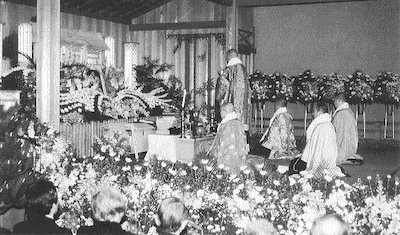
№8 cover story (2003/09/20)
Contributing toward 'Kashinoki-bana'
OSHIMA Masanobu
In the archives about Nohgaku at our house there are dozens of books with a bookplate of "Kashinoki-bana Bunko." The libraries of Noh that my grandfather Jutaro and my father Hisami owned seem to have escaped from Fukuyama Air Raid during the Second World War. "Kashinoki-bana" was the name around this area (Konan-cho, Fukuyama City), from Edo Period to Meiji or Taisho Period. Maybe at a little distant place from Fukuyama Castle, there was a big oak tree here, surrounded by rice and lotus fields.
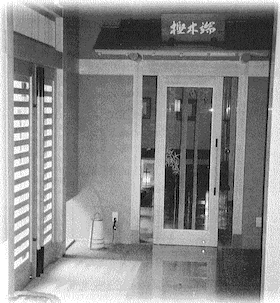 Now, we have wholly reconstructed the first floor of our Nohgaku Do. Some parts are being rotten since my father Hisami built a reinforced concrete three-storied building with a Nohgaku Do in 1971. In the reconstruction of this time we have attached an exhibition saloon named "Kashinoki-bana," in order to aim at a more development of Nohgaku in this area. This room has a Japanese-style entrance and exhibits several Nohgaku materials for your appreciation. I hope the name conveys the ardent wish of my grandfather and my father to raise the Nohgaku tree big.
Now, we have wholly reconstructed the first floor of our Nohgaku Do. Some parts are being rotten since my father Hisami built a reinforced concrete three-storied building with a Nohgaku Do in 1971. In the reconstruction of this time we have attached an exhibition saloon named "Kashinoki-bana," in order to aim at a more development of Nohgaku in this area. This room has a Japanese-style entrance and exhibits several Nohgaku materials for your appreciation. I hope the name conveys the ardent wish of my grandfather and my father to raise the Nohgaku tree big.
And I hope you re-discover an outstanding Japanese culture in our Noh stages, born 650 years ago and brought up throughout Japan, and also in our new room "Kashinoki-bana." I would like to hear about your requests so that you can make a wide and fruitful use of the saloon.
№7 cover story (2003/03/15)
Performing "Shojo Midare"
OSHIMA Teruhisa
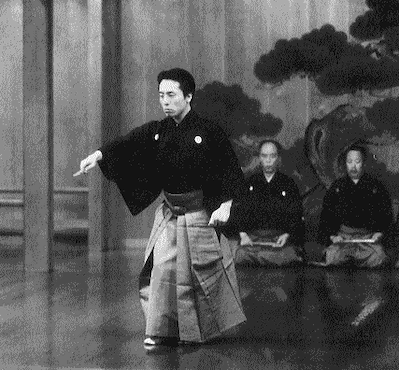 Eight years have passed since I went up to Tokyo to practice as an apprentice at Kita Family after graduating from the senior highschool. Then I became frightened at so much task to learn as a Nohgaku performer and puzzled at the different surroundings. But every time my seniors helped and supported me, and I was able to learn a lot. Especially Mr SHIOZU Akio has lead me enthusiastically, I thank him beyond description.
Eight years have passed since I went up to Tokyo to practice as an apprentice at Kita Family after graduating from the senior highschool. Then I became frightened at so much task to learn as a Nohgaku performer and puzzled at the different surroundings. But every time my seniors helped and supported me, and I was able to learn a lot. Especially Mr SHIOZU Akio has lead me enthusiastically, I thank him beyond description.
Getting permission from Mr SHIOZU and the Shokubun-kai, I perform "Shojo Midare" at Kita Nohgaku Do in Tokyo on September 27. This piece is the one like a mid-term examination for young Nohgaku performers who have been practicing to make it a life work.
"Shojo Midare" is different from "Shojo." You have to express the action of Shojo dancing on the surface by a unique foot step with half-sitting posture matching the Hayashi rhythm. My grandfather Hisami advised me to dance as if Shojo plays with water freely. But it is terribly difficult to keep balance with one leg and half sitting. I think it is one of the most severe pieces technically and physically. I may not perform Shojo frolicking on the water pleasantly, as my grandfather taught me. But I do my best and try practicing until the stage day.
I will devote myself to Nohgaku to return the favor of the warm and continuous support for me.
№6 cover story (2002/09/15)
At the Age of Eighty Eight
OSHIMA Hisami
I have accomplished my career as a Noh performer by playing "Saigyo-zakura" in 1997. I made up my mind to finish and did the piece with satisfaction, though many of my close people said I would be able to perform more. No regrets over my Noh life. Since then I have enjoyed playing Shimai among my school; five years passed, and I am eighty eight years old this year ("Bei-ju, rice age" based on kanji "rice").
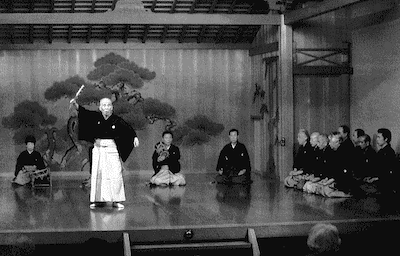 I was able to play Mai-bayashi "Takasago" at "the Spring Exhibition" and shimai "Takasago" at the brand-new Noh exhibitions of Tokyo National Nohgaku-Do in commemoration of my "Rice Age."
I was able to play Mai-bayashi "Takasago" at "the Spring Exhibition" and shimai "Takasago" at the brand-new Noh exhibitions of Tokyo National Nohgaku-Do in commemoration of my "Rice Age."
Because there was a Noh stage at my house from the day of my birth, I did not hesitate to rebuild a stage little by little after my house and the Noh stage burned down at Fukuyama Air Raid, and at last I came to construct a Nohgaku-do. Mr. KITA Roppeita the 14th was glad to say that I was building a castle, but sadly he passed away before its completion. It is not easy to maintain and run a Noh stage in a countryside, but fortunately I am happy to have some efficient successors.
№5 cover story (2002/03/15)
The Dedication of 'Okina Mai'
OSHIMA Masanobu
At Munakata Taisha(Shrine), located by Japan sea and in the northernmost part of Fukuoka Prefecture, Kyushu, close to the Asian Continent, is the god of road enshrined from the ancient times, and the name is found even in "Nihon-Shoki (the oldest history of Japan)." Mr UMEZU Tadahiro of Kita Family performed and dedicated "Okina-mai."
The Noh mask at Munakata Taisha rose onto the surface when the grand priest MUNAKATA Ujikuni tried to lift up the sunken bell at Kanezaki about five hundred years ago. So the mask was thought to be given to the shrine by Dragon God instead of the bell. Since then the mask has been kept as a sacred treasure, and once a year, at the Autumn Festival on October 2, it is carried out from the shrine building, and "Okina-mai" is dedicated to god using the mask to pray for misfortune-removing, longevity, and happiness.
"Okina is, and is not a Noh piece," as is known, and is thought to be exceptional and sacred. The present Noh piece "Okina," leaving a lot of remains before the time of Noh establishment, was sophisticated to be an artificial and noble one. Formally it costs rather much because of the number of participants; At Munakata Taisha it is held as a shinto ceremony, not as a Noh piece.
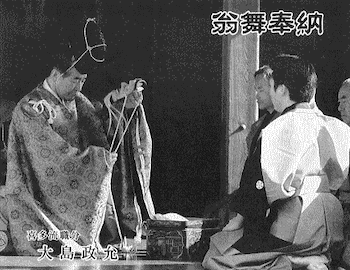 Every year at the New Year Hatsu-Utai Stage and at the Hatsu-mode Stage of Nunakuma Shrine since 1996, Su-utai "Okina" is an inevitable piece of New Year at us. A I was able to join in ji-utai of "Okina-mai" luckily, I came to think about a dedication of "Okina-mai," instead of su-utai, on the stage of Nunakuma Shrine, which has a deep relationship with Kita Family.
Every year at the New Year Hatsu-Utai Stage and at the Hatsu-mode Stage of Nunakuma Shrine since 1996, Su-utai "Okina" is an inevitable piece of New Year at us. A I was able to join in ji-utai of "Okina-mai" luckily, I came to think about a dedication of "Okina-mai," instead of su-utai, on the stage of Nunakuma Shrine, which has a deep relationship with Kita Family.
Having asked and lent "menbako," we dedicated "Okina mai" on January 3 this year, as the New Year Nohgaku Festival. We were able to celebrate New Year with a large audience though it was freezing that day. I hope to fix this to an annual event.
We are planning various stages: the Regular Performances, the first performance of a brand-new Noh "Tomo no Muro-no-ki" (on June 15), and so forth. I hope to express the essence of Nohgaku, that more and more people come to watch our stage, and to sympathize with Nohgaku.
№4 cover story (2001/09/15)
The First Performance of the Brand-new Noh Piece "Tomo no Muro-no-ki"
OSHIMA Masanobu
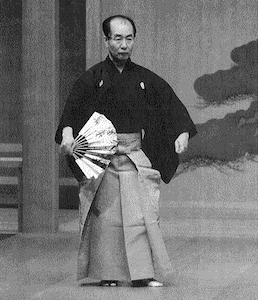 On June 15 of 2002 we perform a newly-made piece "Tomo no Muro-no-ki" at the National Nohgaku Do, written by HOASHI Masanori and choreographed by OSHIMA Masanobu. Mr. HOASHI, a flutist, is famous for his elegant and impressive tone, has a graceful personality. He often comes all the way from Kyoto to our Regular Noh Performances and exhibition stages. Nowadays he is also known as a Kyogen writer. A man of wide knowledge and humor.
On June 15 of 2002 we perform a newly-made piece "Tomo no Muro-no-ki" at the National Nohgaku Do, written by HOASHI Masanori and choreographed by OSHIMA Masanobu. Mr. HOASHI, a flutist, is famous for his elegant and impressive tone, has a graceful personality. He often comes all the way from Kyoto to our Regular Noh Performances and exhibition stages. Nowadays he is also known as a Kyogen writer. A man of wide knowledge and humor.
This new Noh piece includes the poems by OTOM no Tabito and by KAN Chazan and has a main theme of Tabito's affection to his wife Iratsume. I play Shite (OTOMO-no Tabito), my daughter Kinue plays Tsure (Iratsume), Mr. YASUDA Noboru plays Waki (KAN Chazan), Mr. MATSUMOTO Kaoru plays Ai-kyogen (the Boat Station official). As for Hayashi-kata, Mr. HOASHI Masaki plays Fue, Mr. HISADA Shun'ichiro plays Ko-tsuzumi, Mr. KAMEI Hirotada plays O-tsuzumi, Mr. SUKEGAWA Osamu plays Taiko. Ji-utai is done by young fellows of Kita-ryu in Tokyo, and Mr. KAGAWA Seiji serves its master.
I feel terribly sorry to all the participants since I do know how heavy the burden is. When I was young, I had a hard time memorizing Ji-utai rhymes because the last KITA Minoru of Kita-ryu Head Family and TOKI Zenmaro created a new Noh piece after another.
Both the long-time lovers of Nohgaku and the latest beginners surely appreciate this new piece, for it is a fantasy with the local history as a material. OTOMO no Tabito of Man'yo Period and KAN Chazan of Edo Period come across over time and distance on the Noh stage. It is really a relish of Nohgaku, by whose wonderful power I would like to perform successfully.
№3 cover story (2001/04/01)
A Hope at the Beginning of a New Era
OSHIMA Masanobu
Fortunately I had an opportunity to give lectures and performances at a college in Taiwan last year. And it seems to show me a guide to the 21st century. The Taiwanese people helped us with the exchange over the wall of language, which is done by the sympathy to the fantastic beauty of Noh.
This year 2001 is the 130th anniversary of my grandfather OSHIMA Hisataro's birth. He was born in 1871, in the tempestuous years, and lived through Meiji and Taisho Period. He became once a teacher, but KITA Roppeita the 14th told him passionately to be a Noh performer and at last he devoted himself to Nohgaku. He built Oshima Nohgaku Do here in Fukuyama in 1914. Unluckily the Noh stage at that time was burned down at Fukuyama Air Raid in 1945. But my father Hisami tried hard and rebuilt a Nohgaku Do, the only private one in Kita-ryu at that time, and we have kept performing Regular Noh Stages for forty years.
The question Why here in Fukuyama reminds me of the Noh stage at Nunakuma Shrine, which has a kind of fate with Kita Family.
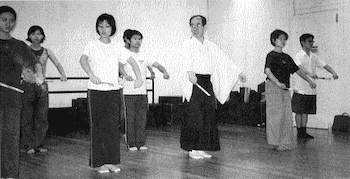 My grandfather created a Noh piece "Tomo no Ura" in 1917. Following his trials of the new piece, I feel strongly the veneration to Nature God and the enthusiasm to express the beauty of Tomo-no-ura and the Seto Inland Sea. I dedicated and performed the Noh piece on the stage of Nunakuma Shrine in 1995 after an interval of 80 years, and we re-established a stone monument by the help of many supporters.
My grandfather created a Noh piece "Tomo no Ura" in 1917. Following his trials of the new piece, I feel strongly the veneration to Nature God and the enthusiasm to express the beauty of Tomo-no-ura and the Seto Inland Sea. I dedicated and performed the Noh piece on the stage of Nunakuma Shrine in 1995 after an interval of 80 years, and we re-established a stone monument by the help of many supporters.
This new year of 2001, my grandfather's 130th anniversary, should be the one to a new era of progress and acceleration.
№2 cover story (2000/09/15)
After Performing "Ohara Goko"
OSHIMA Masanobu
We held "Enjoy Noh Stage" at Hiroshima Asterplaza on July 16. I thank all the members of Hiroshima Oshima Kai for assisting the event from preparation to backstage staff, and I am grateful of many people from all the way.
This time I performed "Ohara Goko" for the first time, it is a scene from Heike Monogatari Emaki.
This piece is rather difficult, expressing mainly with Utai, with no Mai. As I had an operation on my vocal cords, I am in a slight anxiety about my throat. This is, so to speak, an occupational disease of Nohgaku performers. And this occasion led me to decide to perform a piece centering on Utai.
I asked Mr. TOMOEDA Akiyo as the head of Jiutai to consolidate the frame. He was among Jiutai when my father Hisami performed Shite of "Ohara" at Fukuyama in 1983 and the head of Jiutai was his father Mr. TOMOEDA Kikuo.
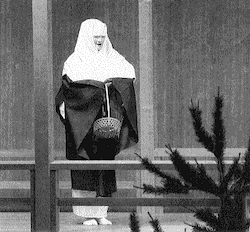 In this piece unexpected numbers of visitors come to the lonesome Jakko-in. Yet all of them, except for Waki, are Buddhist priests in dull and modest dress: Kenreimon-in, Goshirakawa-houo, Naishi, and Dainagon-no-tsubone. The dresses for two Tsure are elaborately embroidered by Ms TAMURA Rei. Their cloth is so soft and delicate that it will be damaged easily though convenient for the performers to sit down. Anyway the dresses had great stage effects.
In this piece unexpected numbers of visitors come to the lonesome Jakko-in. Yet all of them, except for Waki, are Buddhist priests in dull and modest dress: Kenreimon-in, Goshirakawa-houo, Naishi, and Dainagon-no-tsubone. The dresses for two Tsure are elaborately embroidered by Ms TAMURA Rei. Their cloth is so soft and delicate that it will be damaged easily though convenient for the performers to sit down. Anyway the dresses had great stage effects.
The last Noh piece of the day was "Nue" by my son Teruhisa, and Jiutai was led by Mr. SHIOZU Akio. I am not sure that my young son conducted himself well with the poetic piece with continuous violent Kata. He surely keeps on trying, so I hope your support to him.
№1 cover story (2000/04/15)
Dedication to the First Issue of Noh Oshima Soshi
OSHIMA Masanobu
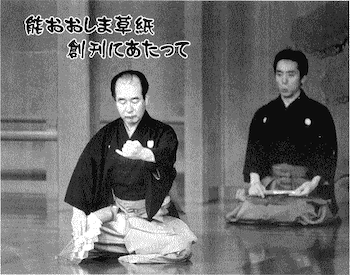 Some years have passed since I reached the 50 years which used to be the length of a man's life. And a new century is coming. Here, I come to meditate the role of the traditional culture Nohgaku and reflect how to inherit it to the next generation.
Some years have passed since I reached the 50 years which used to be the length of a man's life. And a new century is coming. Here, I come to meditate the role of the traditional culture Nohgaku and reflect how to inherit it to the next generation.
I have devoted myself to the art Nohgaku along with my father Hisami for some forty years since I graduated from Jonan Junior Highschool and started an apprentice life in Tokyo. I have to thank all of the supporters who have helped me until this day.
I come up with publishing a bulletin so that my father, who is 85 years old but active now, can write down his old memories and my fellows can give information or express their opinions.
For about two weeks at the end of last year we joined the Noh performances in Poland and Lithuania, where I was entirely impressed by the enthusiastic audience. For I feel sorry that Japanese people hardly have an experience of the traditional cultures in the school education. This situation, I think, lasts more than fifty years after the War. Last year, we gave a practice for the first time at Minami Elementary School near my house and at Tomo Elementary School. Every pupil felt happy with an unfamiliar thing and became interested. In the modern world of internationalization, it is important to realize your own traditional culture in order to brush up your global sense.
We are now preparing for the performances at Asia Traditional Art Congress and for the lectures on Nohgaku to the students in Taiwan. Though Mr OMURA of Kita-ryu and some others stayed before the war, No Noh performances are held yet there after the war. I feel responsibility and at the same time interest what kind of role the 600-year-old Japanese Nohgaku plays now in Taiwan about 50 years after the war.
